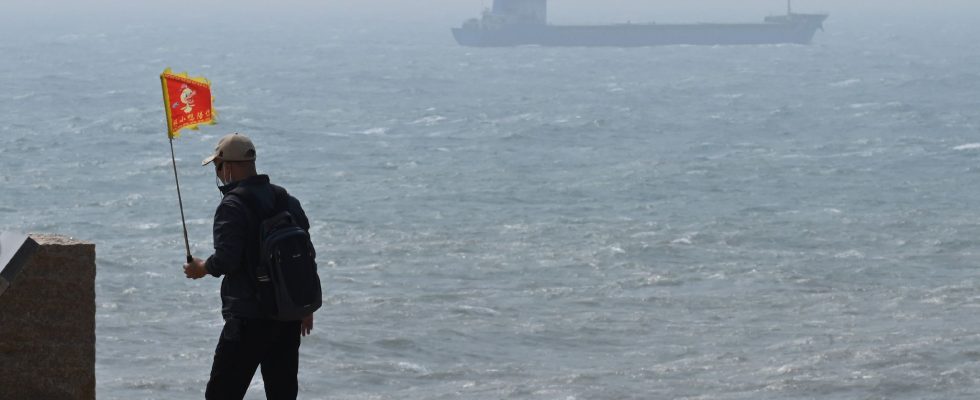The Chinese power delights in the art of intimidation and it demonstrated it again on Saturday April 8. In the morning, the army launched three days of maneuvers around the island of Taiwan in reaction to the meeting in California between the Taiwanese leader, Tsai Ing-wen, and the speaker of the American House of Representatives, Kevin McCarthy. This exchange provoked the ire of the Chinese government: 11 warships and 70 Chinese planes were deployed around the island on Sunday. A show of force justified by Shi Yi, a spokesperson for the Chinese army. These military drills “serve as serious warnings against collusion between separatist forces seeking Taiwan independence and outside forces, as well as their provocative activities,” he said.
This kind of talk is not new. Since October 2021, China has been increasing its maneuvers in favor of “the integrity of its territory”. She criticizes the island for getting too close to the United States, the latter aiming to “severely undermine” Chinese sovereignty, as Mao Ning, a spokeswoman for the Chinese Ministry of Foreign Affairs, lamented last Thursday. . While the last military maneuver dates back to 1995, operations of this type have been increasing since the fall of 2021.
October 2021, first aerial incursions
This Wednesday, October 6, fear is spreading to Taipei, the capital of Taiwan. The “most dangerous period for more than forty years” opens for the country, in the words of Defense Minister Chiu Kuo-cheng. Between October 1 and 4, nearly 150 Chinese military aircraft – including fighter jets and bombers – passed through the island’s air defense identification zone. The pressure exerted by China is considerable. Xi Jinping, who is about to be re-elected as head of the Chinese Communist Party (CCP), has made the reunification of Taiwan with China a priority objective.
The Taiwanese power is worried. President Tsai Ing-wen appeals to the international community: “If Taiwan were to fall, the consequences would be catastrophic for peace in the region and for the democratic alliance system”. Especially since the balance of power is unequal. At the end of 2019, according to a count by the Pentagon (United States), the Chinese army had 1,500 combat planes and 450 bombers while Taiwan had only 400 fighter planes and no bombers. China then begins a long demonstration of force which aims to psychologically wear down the authorities and the inhabitants of the island.
August 2022, the annoying visit
A diplomatic visit and the situation flares up. In the summer of 2022, ten months after the first Chinese maneuvers, the Democratic speaker of the American House of Representatives, Nancy Pelosi (who then held the position of Kevin McCarthy), traveled to Taipei to express her support for her counterpart. The displacement is immediately perceived as a provocation by China, which retaliates instantly. “The People’s Liberation Army […] continues to conduct practical joint exercises in the sea and air space around Taiwan, focusing on joint anti-submarine and assault operations at sea,” the Chinese military’s Eastern Command said in a statement. .
Live fire exercises are simulated about twenty kilometers from the Taiwanese coast. These three days of maneuvers are the largest military exercises ever carried out near Taiwan. The Chinese Ministry of Commerce announced at the same time economic sanctions, including a suspension of the export to Taiwan of natural sand, a key component in the manufacture of semiconductors, one of the main exports of the island. A meaningful gesture since if China cares so much about Taiwan, it is also in view of its economic weight.
December 2022, constant pressure
New demonstration. In the aftermath of the Christmas holidays, the Chinese army reaffirms its power. On Sunday, December 25, it deployed 71 combat aircraft, and again accused the United States of collusion with Taiwan. Since August, China has intensified its pressure with one of the most effective means of conducting this psychological warfare: the overflight of the Taiwanese air defense zone by its warplanes. Over the year 2022, more than 1,700 incursions of this type have been recorded, double that of 2021 and 17 times more than in 2020.
If China shows the muscles at this moment of the year, it is still in reaction to a rapprochement between Taiwan and its American ally. The country led by Xi Jinping displays its “firm opposition” after the adoption of an American defense law, the “National Defense Authorization Act”, authorizing in particular 10 billion dollars of military aid and arms sales to Taiwan.
“This behavior of the Chinese Communist Party once again highlights its mentality, which is to use force to settle disputes and undermine regional peace and stability,” accused the Taiwanese Ministry of Defense at the time. The two blocs seem increasingly irreconcilable.
January 2023, permanent state of alert
57 aircraft and four ships. On January 9, 2023, China is continuing its large-scale maneuvers. This time, the Chinese elite corps focuses its exercises on land strikes and sea assaults. The scenario of an invasion is no longer science fiction, as expressed by CCP specialist Willy Law to L’Express.
The state of alert is now permanent in Taiwan, reflecting the renewed tension that has been observed since the beginning of April in reaction to Tsai Ing-wen’s stopover in the United States, before and after a trip to Latin America. Proof that Taiwan does not bow to pressure from its neighbour.
